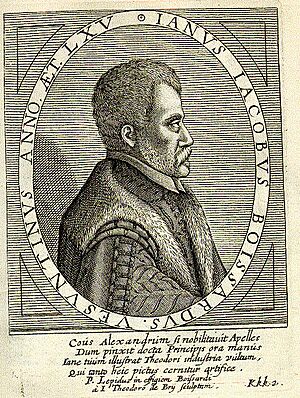Jean-Jacques Boissard facts for kids
Jean-Jacques Boissard (born in 1528, died on October 30, 1602) was a very smart person who loved old things and wrote poems in Latin, a language from ancient Rome. He was an antiquary, meaning he studied and collected old objects, and a Neo-Latin poet, which means he wrote poems in Latin, a language from ancient Rome.

Life of Jean-Jacques Boissard
Jean-Jacques Boissard was born in a city called Besançon in France. He went to school in Leuven, which is now in Belgium. But he secretly left his studies there.
He then traveled a lot! He went through Germany and spent several years in Italy. Sometimes, he didn't have much money during his travels.
While in Italy, he became very interested in antiquities. These are old objects and historical items. He started collecting many cool things from Rome and the areas around it.
After Italy, he visited the islands of Greece. But he got sick and had to go back to Rome. There, he finished collecting his treasures before returning to France.
Back in France, he couldn't openly practice his Protestant religion. So, he moved to Metz, where he lived until he passed away.
Works and Books by Boissard
Jean-Jacques Boissard wrote texts and drew pictures for books by other artists like Robert Boissard and Theodor de Bry. Here are some of his most important works:
- Poemata (1574) - This was a collection of his poems.
- Emblemata (1584) - A book of emblems, which are pictures with short texts that teach a lesson.
- Icones Virorum Illustrium (1597) - This book featured pictures of famous and important people.
- Vitae et Icones Sultanorum Turcicorum, etc. (1597) - This work included lives and pictures of Turkish sultans.
- Theatrum Vitae Humanae (1596) - This title means "Theater of Human Life."
- Romanae urbis topographia et antiquitates (1597–1602) - This book was about the geography and old artifacts of the city of Rome.
- De Divinatione et Magicis Praestigiis (1605) - This book explored topics like fortune-telling and magic tricks.
- Habitus Variarum Orbis Gentium (1581) - This book showed the different clothes worn by people around the world, with 70 colorful illustrations.

